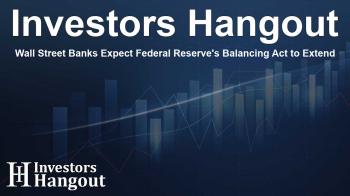Wall Street Banks Expect Federal Reserve's Balancing Act to Extend

Wall Street's Predictions on the Federal Reserve's Balance Sheet
As we navigate the complexities of economic recovery, Wall Street's major banks have introduced a new perspective regarding the Federal Reserve's balance sheet reduction efforts. According to recent meeting minutes from the Federal Reserve's policy discussions, banks now anticipate that the conclusion of the Fed's balance sheet shrinkage will be pushed back.
Insights from the Recent Federal Reserve Meeting
In the wake of the latest policy meeting, which took place in December, it's clear that financial institutions conveyed updated expectations to the Federal Reserve. Ahead of this particular meeting, banks communicated to the Fed that they now project the balance sheet reduction process—termed quantitative tightening (QT)—to wrap up in June of this year. This timeline reflects a slight extension from their previous assessment provided in November.
Interest Rate Adjustments and Economic Control
During the December gathering, the Federal Reserve made a pivotal decision to reduce its interest rate target range from 4.5% down to 4.25%. This adjustment comes amidst an environment where many are reassessing future rate cuts and inflation forecasts. Interestingly, while the Fed didn't unveil any groundbreaking changes regarding its balance sheet during the meeting, it did implement a subtle tweak in the rate paid on its reverse repo facility. This move aims to encourage market participants to shift their cash from the Fed's holdings into the private sector.
The Federal Reserve's Balance Sheet and Market Volatility
As discussions regarding monetary policy continue to evolve, many analysts are looking toward 2025 as a significant year for the Fed. It's anticipated that this will mark the end of the central bank's efforts to unwind its massive bond holdings, which were significantly expanded in response to the COVID-19 pandemic. Originally swelling to an astounding $9 trillion due to intensive bond purchasing, the Fed has successfully reduced these holdings to just under $7 trillion. The current strategy focuses on shedding Treasury and mortgage bonds to eliminate excess liquidity in the market.
Liquidity Levels and Monetary Policy Stability
The intention behind these actions is to achieve a more stabilized liquidity environment where market volatility can normalize, allowing the Federal Reserve to maintain better control over the federal funds target rate—a key tool in influencing economic momentum.
Future Challenges Facing the Fed
As we look ahead, it's crucial to consider the challenges facing the Federal Reserve. During the last meeting, banks indicated that they believe the QT process could conclude by May, estimating the Fed’s total holdings to be around $6.375 trillion. This projection suggests a potential steadying in banking sector reserves, expected to exceed the current levels.
However, there is ongoing uncertainty regarding government financing needs, particularly as political shifts can introduce new variables into the economic dialogue. Additionally, fluctuations in the private repo market have already created notable volatility, influencing how banks utilize the Fed’s Standing Repo Facility to access immediate cash flow.
Implications of Government Borrowing Limits
The minutes from the recent meeting flagged critical issues that could shape the Fed's operations in the upcoming year. The potential reinstatement of government borrowing limits may complicate the Fed's ability to gauge liquidity effectively, while such limits may also lead to increased inflows into the reverse repo facility, due to decreased Treasury bill issuance.
As we continue to monitor the dynamics between Wall Street and the Federal Reserve, it's clear that banks' forecasts and the Fed's strategic pivots will play a pivotal role in shaping the economic landscape in the near future.
Frequently Asked Questions
What do the banks forecast about the Federal Reserve's balance sheet reduction?
Banks have indicated that they now expect the Federal Reserve's balance sheet reduction process to conclude in June of this year, a slight extension from previous estimates.
What major decision did the Federal Reserve make during the December meeting?
During the December meeting, the Federal Reserve reduced its interest rate target range from 4.5% to 4.25% amidst changing expectations regarding future rate cuts.
What is the significance of the reverse repo facility adjustment?
The adjustment in the reverse repo facility rate aims to encourage market participants to shift their cash away from the Fed's holdings and foster liquidity in private markets.
How has the Federal Reserve's balance sheet changed since the COVID-19 pandemic?
Since the COVID-19 pandemic, the Federal Reserve's balance sheet grew to around $9 trillion but has since been reduced to just under $7 trillion through quantitative tightening measures.
What challenges may the Federal Reserve face in the future?
Potential government borrowing limits and fluctuations in the private repo market could complicate the Federal Reserve's assessment of liquidity and influence its operations.
About Investors Hangout
Investors Hangout is a leading online stock forum for financial discussion and learning, offering a wide range of free tools and resources. It draws in traders of all levels, who exchange market knowledge, investigate trading tactics, and keep an eye on industry developments in real time. Featuring financial articles, stock message boards, quotes, charts, company profiles, and live news updates. Through cooperative learning and a wealth of informational resources, it helps users from novices creating their first portfolios to experts honing their techniques. Join Investors Hangout today: https://investorshangout.com/
Disclaimer: The content of this article is solely for general informational purposes only; it does not represent legal, financial, or investment advice. Investors Hangout does not offer financial advice; the author is not a licensed financial advisor. Consult a qualified advisor before making any financial or investment decisions based on this article. The author's interpretation of publicly available data presented here; as a result, they should not be taken as advice to purchase, sell, or hold any securities mentioned or any other investments. If any of the material offered here is inaccurate, please contact us for corrections.
